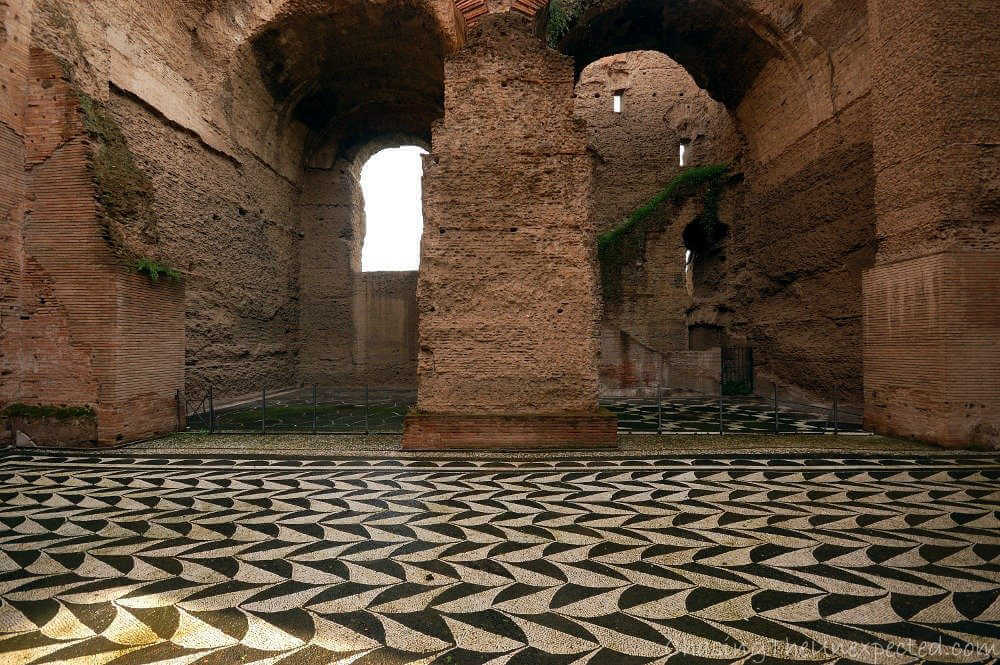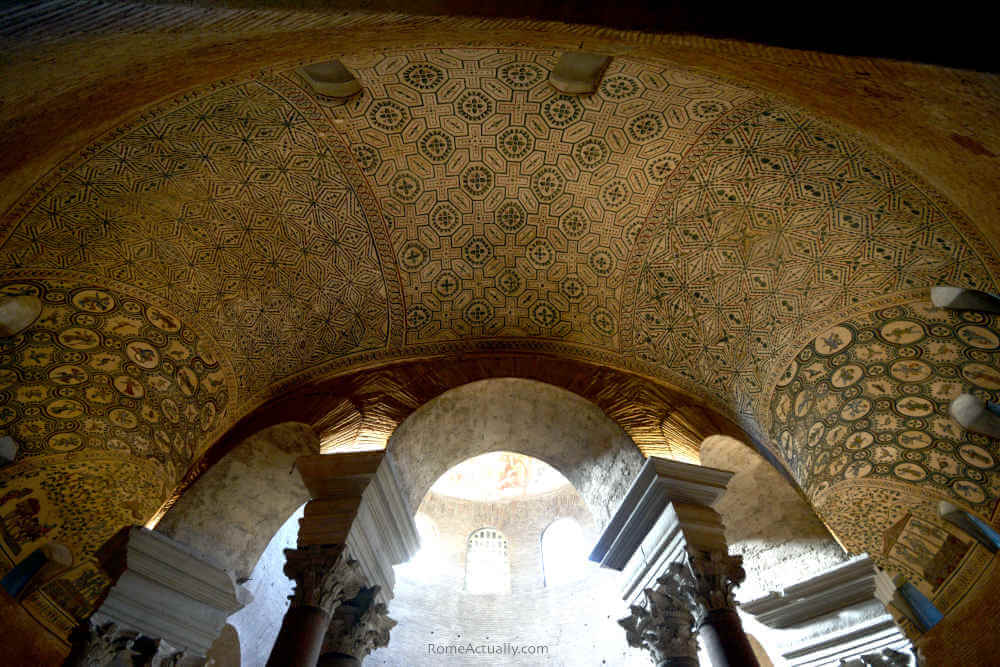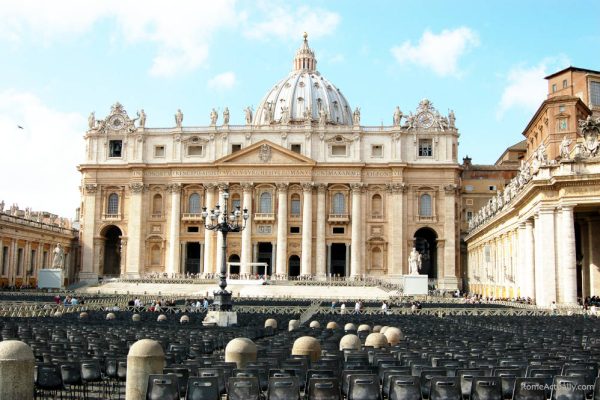Most of the year, Rome is crowded. In some months, overcrowded. One of the best times to come to Rome is spring, but letting aside the great weather, you have to come to terms with crowds of tourists in all the most famous attractions. In summer, an unforgiving heat adds to the already challenging experience.
Thankfully, Rome is a bottomless source of landmarks to visit, so if you want to enjoy a slow-paced, better-quality travel experience, it’s possible even in such a popular tourist destination.
From tips on what season to prefer to when to visit popular landmarks, there are many ways to enjoy slow travel in Rome rather than being dragged by the crowds. I will be also suggesting some alternative monuments and museums in case you are open to exploring lesser-known attractions.
Disclaimer 1! I am in no way suggesting that you skip these places. This article simply wants to provide an alternative if you are tired of standing in line, if you don’t want to be in the middle of big crowds, or even to explore quieter landmarks in the busiest hours when famous monuments are more likely to be packed.
Disclaimer 2! I am perfectly aware that no other church in Rome equals Saint Peter’s Basilica. However, if you don’t think you can bear an hour under the sun, here you will find a few alternatives for the day so that you can visit St. Peter’s Basilica right before closing time when the biggest crowds start fading.
Check out our step-by-step guide to planning a trip to Rome

Tips for beating the crowds in Rome
Avoid the high season
This is very much straightforward but I still see many travelers who only arrive in spring and summer because of lack of planning. And then they obviously regret it because it’s either too crowded or too hot. Or both!
A crucial part of the planning process is to decide when is the best time to go. If you can afford flexible holiday time, pick fall or winter. Winter in Rome is mild and there are very few crowds. Right around Christmas, you will find Via del Corso packed with last-minute gift shoppers, but other than that, you will have a great and relaxing holiday.
Check out our guide to the best time to visit Rome
Prefer early mornings and evenings
If you have no other option but to find yourself in Rome in spring or summer, try to hit the biggest tourist draws early in the morning or in the evening. For example, you can go to the public squares such as Piazza Navona, Piazza di Spagna (Spanish Steps), and Trevi Fountain any time so why not at 6 am?
I know you are on holiday, but if you want to beat the crowds in Rome, you’ll need to compromise. You can always go back to your room after lunch for a nap, especially if you have a hotel in Rome’s city center.
Monuments and museums are not going to open at 6 in the morning, but if you can book an early entry or some two hours before closing, the biggest crowds will have already faded away. You can do so either by booking exclusive tickets from the official websites or opting for early or late private tours of the Vatican Museums.
Visit lesser-known landmarks
I know that sights like the Trevi Fountain and the Spanish Steps are world-famous. However, there are so many other places to visit in Rome that attract fewer visitors simply because “influencers” don’t notice them so they don’t stand there to take pictures.
Get off the beaten track, venture into the little alleys. In Rome, every corner is a piece of history, every sculpture is a votive station or a coat of arms of a noble family. You will be surprised at how much more you can enjoy the city walking an empty backstreet rather than soaking in and being dragged by the crowds.
I wrote an ebook with four self-guided walks in Rome in four different neighborhoods so that you can explore the city at your own pace, without a guide, and visit popular landmarks as well as hidden gems. Check it out here!
Take a day trip
Don’t underestimate the power of day trips! Rome has a huge wealth of options for fantastic day trips. While some towns will be quite busy (even though not as crowded as the Trevi Fountain!), there are plenty of places where you can enjoy a lovely walk without having to elbow your way through the crowds.
I reckon some of the busiest places in Rome’s surroundings will be towns like Tivoli and Civita di Bagnoregio while areas like Roncigliano or even the Bolsena Lake will be more pleasant.
Find an alternative
Rome is so packed with ancient landmarks and artwork that it won’t take you a long time to find something to see and do if you don’t manage to enter one. Of course, there are some monuments that can’t be replaced such as the Pantheon and the huge Vatican Museums.
However, if visiting them means that you need to queue for half an hour or an hour under the sun at 40°C (104°F), you really need to consider if you are at risk of getting sick.

Alternative Rome landmarks to consider
Alternative to Colosseum – Baths of Caracalla
Everybody goes to the Colosseum. Some because genuinely interested in the engineering and architecture behind it, others because they want a selfie with a world-famous monument in the background. In the latter case, and if you are not really interested in learning about the history and construction of the Colosseum, please opt for an alternative. Especially if you come in the high season.
One of the closest and most stunning alternatives to the Colosseum is the Baths of Caracalla. These were a public wellness center complete with everything you need in modern wellness centers including a pool with hot water, one with lukewarm water, and one with cold water. They also included changing rooms, a gym, and a library. As if this wasn’t enough, today, the Baths of Caracalla is home to Rome’s largest Mithraeum, a temple devoted to the Persian god Mithra.
The site is huge and you can walk around the different sections, some of the statues used to decorate it, the mosaic floors, and the descriptive panels that show you an idea of how it was in its heyday.

Alternative to Colosseum – Trajan’s Markets
Another fantastic site in Piazza Venezia right in the heart of the city and even close to the Colosseum that it’s so unbelievably crowd-free despite its worth is the Trajan’s Markets. Unlike their name might suggest, these were not the venue for cattle and veggie markets but they served as offices and administrative hubs for the adjacent Forum of Trajan.
When I visited the Trajan’s Markets, I had predicted that I would stay for an hour or so. In the end, I stayed more than three hours. I just couldn’t stop exploring the fantastic collection of relics found in the Imperial Fora, the reproduction of temples and statues, and the great explanatory panels. You can also step into the outside area and walk into Trajan’s Forum.

Alternative to Colosseum – Imperial Fora
I’m suggesting the Imperial Fora as an alternative to the Colosseum as a way to avoid the largest crowds in Rome, but I would recommend this fantastic archaeological site anyway.
This is where the emperors would organize their public events, and build temples, majestic buildings, and monumental squares to make them the center of Ancient Rome’s political life. It’s a fantastic site accessible from the entrance close to Trajan’s Column.
Alternative to Colosseum – Ostia Antica
Are you an archaeology and history buff? Ostia Antica is an ancient city waiting to be explored and discovered. You will see where the residents used to live, where the local shops and storage areas were located, the ruins of ancient public baths and also where they held public events.
Ostia Antica is easy to reach from Rome via a short train ride and even though many visit, it’s so huge that it won’t feel crowded.

Alternative to Saint Peter’s Basilica – Basilica of Santa Maria della Vittoria
Santa Maria della Vittoria Basilica is a little gem in the Castro Pretorio neighborhood not far from Termini and behind the monumental fountain of the Moses designed by Domenico Fontana in the 16th century.
Even though not huge, this church located in Via XX Settembre off Largo di Santa Susanna is a true jewel packed with artwork and decorated in the smallest detail. Designed by Carlo Maderno in the 17th century, the main highlight of this Baroque Basilica is the stunning sculpture Ecstasy of Saint Teresa by leading artist Gian Lorenzo Bernini.

Alternative to Saint Peter’s Basilica – Basilica of Santa Maria Sopra Minerva
Considering its central position a stone’s throw from the Pantheon, you will find this beautiful church surprisingly easy to access. The Basilica of Santa Maria Sopra Minerva is hardly empty of visitors but there is no line at the entrance.
This is a very ancient church as it was first founded in the 7th century where previously was a temple devoted to Minerva and revamped in Gothic style in the 13th century. Impossible to miss is Michelangelo’s statue of the Resurrected Christ (Cristo Risorto).
Facing the entrance is an ancient Egyptian obelisk supported by a marble statue with the shape of an elephant carved by Bernini. A small but totally worthy gem here is the beautiful cloister, on your right-hand side when you leave the church.

Alternative to the Vatican Museums – Museo Nazionale Romano in the Diocletian Baths
Museo Nazionale Romano is hosted in four venues around Rome’s city center and this one set in the Baths of Diocletian near Termini station is the largest. This is by far one of my favorite museums in Rome.
It’s huge and displays the largest collection of classic and ancient Roman relics, work tools, artwork, and decorative objects in the world. While the Vatican Museums show more modern artwork by famous artists, Museo Nazionale Romano is more of a huge archaeological collection. During your tour, you can also visit the Baths of Diocletian.

Alternative to the Vatican Museums – Capitoline Museums
Not as famous and visited as the Vatican Museums, the Capitoline Museums will take you around the history of Rome from its inception to modern times traveling across centuries and important events.
I visited the Capitoline Museums a few times and every time I discovered something new. This is why I always suggest devoting a couple of hours to this museum if you are into Roman history. Context Travel runs a fantastic private tour of the Capitoline Museums led by a scholar.

Alternative to Piazza di Spagna – Piazza del Popolo
Piazza di Spagna is the square at the foot of the famous Spanish Steps, while Piazza del Popolo lies at the foot of the Pincio hill and marks the entrance to the streets of the Tridente area. Two squares but two completely different experiences.
From Piazza del Popolo, you won’t see any monumental staircase, but it still boasts a wealth of landmarks from fountains to churches to chapels to a historical gate.
Alternative to Galleria Borghese – Palazzo Barberini
Galleria Borghese deserves all its fame, but Palazzo Barberini is a palace that not only houses famous and beautiful artwork but also a very important historical palace. Commissioned by the Barberini Pope Urban VIII, the wonderful palace is the collaboration of three of the leading artists and architects of the Roman Baroque, Carlo Maderno, Gian Lorenzo Bernini and Francesco Borromini.
Inside, a large collection of paintings and sculptures by some of the most famous artists including Caravaggio and Raphael. Before leaving, don’t forget to climb the two famous staircases of the palace, one work of Bernini and the wonderful helicoidal one, unmistakably by his rival Borromini.

Alternative to Villa Borghese – Villa Torlonia
Granted, Villa Borghese is huge so you will always find a corner with fewer people. Apart from Galleria Borghese, some of the places in the park where you are likely to find more visitors are the Pincio Terrace, the temple of Diana, and the lake.
Villa Torlonia, on the other hand, is much smaller but packed with landmarks. Palaces like the wonderful Casino Nobile, the Roman residence of Benito Mussolini, and its bunker underground, the quirky House of the Owls, and the exotic-style Moorish Greenhouse (Serra Moresca) are a fantastic glimpse into Rome’s modern history and architecture.
Of course, being a park, it also offers the alleys for lovely strolls and some relaxing time out of the city’s traffic. Villa Torlonia is in Via Nomentana so not in the strict city center but in a fantastic residential area with many good restaurants, coffee shops, and landmarks to explore. This is actually one of my favorite areas to book a hotel in Rome.

Alternative to Santa Maria in Trastevere Basilica – Basilica of Santa Cecilia in Trastevere
Santa Maria in Trastevere Basilica is right in the heart of the touristy part of Trastevere so that’s probably why it steals all the thunder from the beautiful Basilica of Santa Cecilia in Trastevere. However, the latter promises a fantastic and complete experience.
Granted, Santa Maria in Trastevere shows beautiful mosaics on the facade and it’s stunning inside. But so is Santa Cecilia Basilica, built on the site of Roman patrician Cecilia who was martyred in 230 AD.
Visiting this church dominating the view of Piazza Santa Cecilia will show you a modern church decorated with fantastic polychrome marble, a mesmerizing crypt with a forest of arches and pillars, and an underground level of ancient Roman buildings.

Alternative to Trastevere – Quartiere Coppedè
The now-gentrified former working-class neighborhood Trastevere, located beyond the Tiber from the historic center and the Jewish Ghetto, attracts a huge number of visitors. From strolling around its cobbled alleys to sipping a coffee to exploring Roman traditional cuisine, Trastevere’s charm doesn’t show any sign of cooling.
While the vibe of Trastevere is difficult to reproduce, if you want to avoid the crowds that in some months are really overwhelming especially when queueing for a single meal, consider visiting the bizarre Coppedè Quarter in the Trieste neighborhood.
This is a Liberty area not far from Piazza Fiume where buildings are decorated with animal and fairy tale figures borrowed from the classic Greek and Roman traditions with Gothic, Baroque, and medieval contaminations.
Not being a touristy area, rest assured that whichever restaurant you will stop for lunch (with no need for queueing!) will serve authentic and tasty dishes.
Less crowded landmarks in Rome worth your time
Castel Sant’Angelo
This always comes as a surprise. Castel Sant’Angelo, or the Hadrian Mausoleum, is one of the most photographed monuments in Rome. Ponte Sant’Angelo bridge connecting it to the historic center is always crammed with tourists and passers-by. Yet I never see a line at the entrance.
Castel Sant’Angelo is one of the best-kept oldest landmarks in Rome. Its history spans from the 2nd century to the modern era, it has continuously been used throughout the centuries changing purpose and style. This is probably the best place in Rome to appreciate the layers of history of the city.
Take advantage of the lack of queues to visit one of the most important monuments in Rome. I visited many times but once with the Roman Icons tour run by Walks and I felt it tremendously enhanced the quality of my visit and increased my knowledge of the place.

Sant’Agnese Fuori le Mura complex
Maybe you don’t know, but there are interesting old monuments even outside the Aurelian Walls. The complex of Sant’Agnese Fuori le Mura in the Via Nomentana is a fantastic example.
Easy to reach by metro (line B – Sant’Agnese Annibaliano stop), you will see a medieval church, large catacombs as its undergrounds, a Constantinian Basilica ordered by the emperor’s daughter Costanza as a funerary space built beside Sant’Agnese’s burial place, and the mausoleum of Costanza herself decorated with wonderful mosaics.
Trinità dei Monti Church and complex
Literally every single visitor to Rome, whether it’s their first, second, or tenth time, goes to Piazza di Spagna to either take a picture of or climb the Spanish Steps. However, how many enter the church of Trinità dei Monti on top? A tiny percentage, I believe. And that’s a pity.
One of the five French churches in Rome, its oldest structure is a Gothic one and dates back to the early 16th century. The current look is the result of several architectural styles and some of the greatest architects such as Giacomo Della Porta and Carlo Maderno.
Before going, I strongly suggest you reserve your spot directly with the friars to visit the cloister and see the famous anamorphic frescoes, the astrolabe solar clock, and the Mater Admirabilis fresco.
WANT TO READ THIS LATER? PIN IT TO YOUR BOARD!






